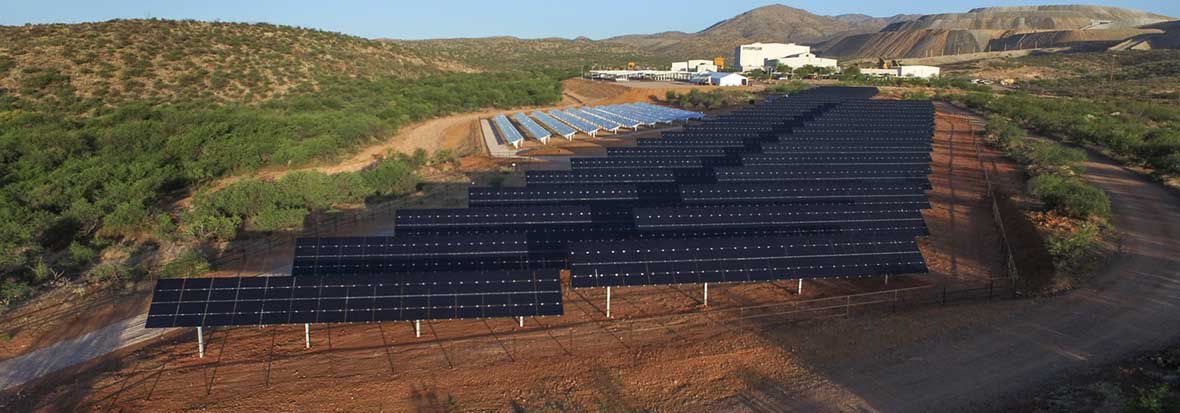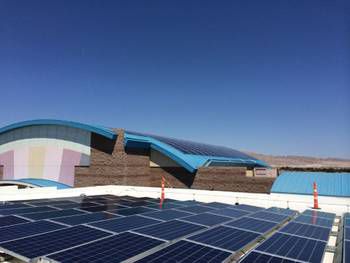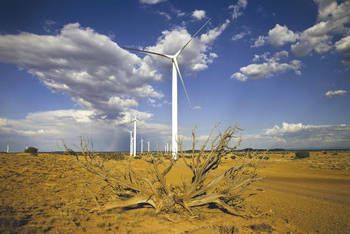Installation and maintenance of wind turbines are more complicated. This type of renewable energy-generation source is typically installed in rural areas and takes up a great deal of land. Turbines contain mechanical components and experience wear and tear, requiring regular maintenance—normally twice per year. In addition, wind turbine installations are most effective in areas where the minimum sustained wind speed is at least 12 mph.
Geothermal technology can be used to produce electricity at utility scale. However, applications in commercial and residential settings are mainly limited to heating and cooling. This technology typically uses the heat from large reservoirs of water found deep underground. Harnessing these massive heat sources to produce steam that drives large turbines, rather than boiling water with fossil fuels, reduces the emissions from steam turbine power plants dramatically, to less than 5% as compared with coal. The remaining source of emissions is due to naturally occurring dissolved gasses present in the underground reservoir.
Fuel cells produce electricity based on a chemical reaction that strips electrons from fuel containing hydrogen and directs the electrons toward oxygen through a sandwich of close-coupled bipolar plates and electrolyte. Electrons passing across the terminals result in electric current flow. The most common fuel used is natural gas. However, because the process does not include combustion, there are no pollutant byproducts. This technology is considered renewable only if the fuel source used is renewable. The typical byproducts are carbon dioxide, water, and heat.
Biomass electricity generation uses organic waste as fuel. The fuel is burned to create steam that, similar to geothermal plants, drives large turbine engines. One example is the methane byproduct from rotting landfill waste that is normally vented or flared off to the atmosphere to prevent dangerous gas buildup beneath the soil. To produce electricity, the methane is captured, processed, and burned to produce steam. This is a renewable and carbon-neutral process, but not necessarily a clean process. Advances in pollution-control technologies reduce emissions, but do not eliminate them.
One additional renewable energy-generation technology worth mentioning is hydro. In use for more than 100 years, hydro is the most widely used renewable energy-generation technology worldwide, accounting for 70% of the world's renewable energy generated, according to REN21 (the Renewable Energy Policy Network for the 21st Century). This technology works by harnessing the power of flowing water that rotates turbines coupled with an alternator that generates electricity. This is similar to the idea behind wind power, but with a more constant source of energy. Due to complexities, cost of deployment, and the need for a steady stream of water, this technology is not widely employed for connection to residential and commercial-building energy systems in the U.S.
Policies and Incentive Programs
Government programs have had significant impact on the level of adoption and increased deployment of renewable energy technologies. Two of the most widely recognized programs are the IRS' Residential Renewable Energy Tax Credit and Business Energy Investment Tax Credit. Although originally scheduled to expire at the end of 2016, these programs were amended in December 2015 to extend through to 2019 (and beyond, in some instances). Both programs provide a tax credit based on the in-service date of the renewable energy system.
The Residential Renewable Energy Tax Credit is a federal personal tax credit available to homeowners that install a renewable energy system. The residential program was amended to extend the in-service deadline for photovoltaic and solar thermal technologies until the end of 2021. A 30% credit is available until the end of 2019, at which time the credit will step down to 26% until the end of 2020 and 22% until the end of 2021. Incentives under this program for other technologies (fuel cell, small wind, and geothermal) will no longer be available at the end of 2016. The residential tax credit program will expire at the end of 2021.
The Business Energy Investment Tax Credit is a federal corporate tax credit available to businesses that install a renewable energy system. This program was also amended to extend beyond 2016. The credit for photovoltaic and solar thermal technologies will remain at 30% until the end of 2019. It will then be reduced to 26% until the end of 2020, 22% until the end of 2022, and then 10% thereafter. Large-wind installations (turbines rated at more than 100 kW) will also see a staged reduction in the credit from 30% through to the end of 2016, 24% until the end of 2017, 18% until the end of 2018, and finally 12% until the end of 2019. At the end of 2019, wind installations will no longer be eligible for a tax credit under this program.
The current 10% tax credit for geothermal-electricity-generating installations does not have an expiration date. However, installations that use heat pumps for combined heat and power systems will not be able to claim credit after 2016.
Owners of renewable energy-production systems that sell the generated electricity, such as investor-owned utilities or those sold under a power purchase agreement, are eligible to take advantage of the Renewable Electricity Production Tax Credit. The technologies allowed under this program include wind, biomass, geothermal, hydroelectric, and marine energy sources. The tax credit applies during the first 10 years of operation and provides a credit equal to 0.015 cents/kWh, with an inflation adjustment from 1993 dollars for some technologies and half of this amount for others. The inflation adjustment factor is published by the IRS each year. The credit for wind facilities will be phased out at the end of 2019. Wind facilities commencing construction in 2017, 2018, and 2019 will experience a reduced tax credit of 20%, 40%, and 60%, respectively.
Another program with positive impact on the increased implementation of renewable energy and increased installed base numbers are state renewable portfolio standards. As of October 2015, 29 states have enacted policies that place obligations on utility companies to meet minimum percentages of renewable energy sources. Additionally, eight other states now have renewable energy goals that have the potential to become legal mandates in the future.
Connection to Existing Electrical Services
Installing a new onsite renewable energy system at existing buildings or properties can sometimes seem onerous, especially when the existing distribution was designed prior to or without the foresight of modern codes related to paralleling local generating sources of electricity with the utility. NFPA 70: National Electrical Code—2014 (NEC) contains provisions for the safe installation of photovoltaic (NEC Article 690), fuel cell (NEC Article 692), and wind electric systems (NEC Article 694) to electrical distribution systems in buildings.
NEC Article 705 covers installation of one or more electric-power-production sources operating in parallel with a primary source of electricity. The point of connection from the output of a local source of electric power is specifically addressed in NEC Article 705.12.
NEC 705.12(A) allows local power-production sources to be connected to the supply side of a utility service. However, it is restricted to the rating of the utility service. The rationale for this requirement is that energy output from the generating system must go somewhere—think Kirchhoff's Current Law. If it is not consumed by loads within the facility electrical system, it will feed back to the utility. If the aggregate capacity of the local power-production sources exceeds the utility rating, the service equipment will be overloaded, which may cause a fire.
NEC 705.12(D) allows a load-side connection of utility-interactive inverters, but with additional restrictions. Utility-interactive inverters are used in photovoltaic, fuel cell, and wind-energy production to convert voltage from dc to ac under the following conditions:
- There must be a single dedicated means to disconnect all inverters connected to one distribution system.
- Equipment bussbar ratings must be sized to support 100% of the utility overcurrent protection device (OCPD) and 125% of the inverter output circuits. Alternately, if the utility input and inverter input are located at opposite ends of the bussbar, the sum of the utility OCPD and inverter OCPD may be sized up to 120% of the bussbar rating.
- All equipment containing connection of multiple sources must be marked.
- Circuit breakers must be suitable for backfeed.
- Circuit breakers that are back-fed and are plug-in type must be secured by an additional fastener unless listed and identified as interactive.
When integrating alternative power and existing electrical systems, take the time to understand policies, incentives, procedures, and codes to ensure a successful project.
Robert R. Jones Jr. is the associate director of electrical for the Las Vegas office at JBA Consulting Engineers. He has experience in multiple market sectors including hospitality, commercial, medical, and government projects.
Leslie Fernandez is senior project engineer, electrical at JBA Consulting Engineers. He specializes in renewable energy systems and complex medium and high voltage distribution systems.










